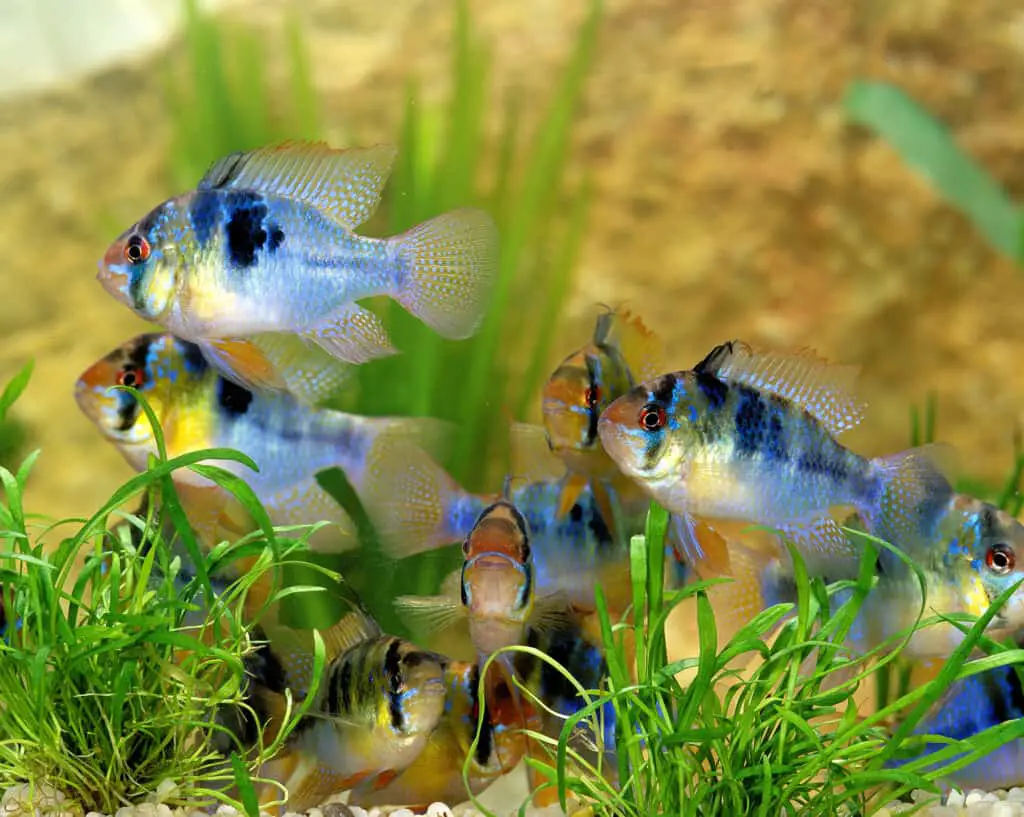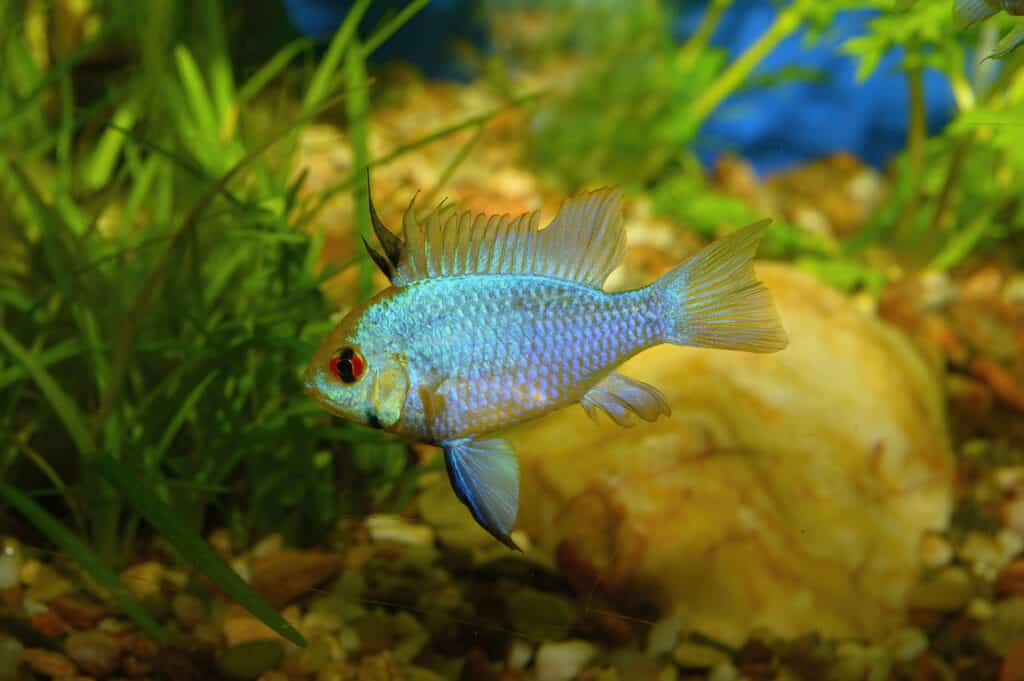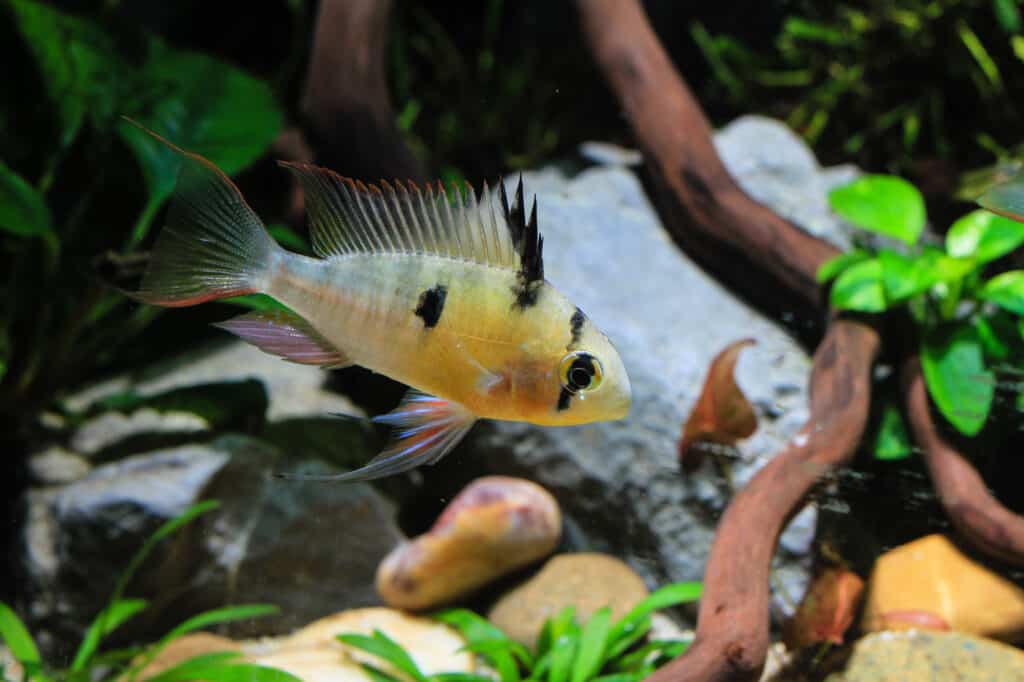
Ram Cichlids are a favorite for many members of the fish-keeping community.
Their spectacular colors, unique behavior and the ability to both be added as a showpiece, or as a group allow them to be used in many tanks.
However, since there are several types of Ram Cichlids, each with their unique look it is sometimes asked if the different types can be kept in the same tank.
Ram cichlid variations can be kept together in the same tank, the exception being the Bolivian ram. Some caution should be used however, especially if there is a desire to breed a specific color, or keep a breeding line true, as the variations can and will cross-breed making hybrids a strong possibility if variations are kept together.
Let’s jump into the compatibility between the variations of ram cichlids, along with how advisable it is to mix the variations depending on different situations and plans for a tank.
Compatibility of Ram Cichlid Variations
Though each variation has unique attributes and appeal, in general, they all have the same tank requirements that allow them to be compatible in the same tank, the exception being the Bolivian ram.
If you want to learn more about the different variations of Ram Cichlids, here is a blog post I wrote all about them.
The main discrepancy with the Bolivian ram is their desire for cooler temperatures.
This doesn’t mean it is not impossible to have them paired with the other variations such as the popular German Blue Ram, and Golden Ram, however the temperatures that would allow this to have the highest success would have the water temperatures at the extreme top of the Bolivian Ram range, and the extreme bottom of the other variation range putting both variations outside the middle of their preferred temperature.
Otherwise, the other parameters of the water chemistry are almost identical, with all variations preferring slightly acidic water with pH in the range of 6 to 7.5.
Their method of eating is also consistent between the variations.
Ram Cichlids are sifter feeders, meaning they go through the substrate, sifting it to pull out pieces of food to eat.
Due to this, sand is the recommended substrate for all Ram Cichlid variants.
All the variants also share in the way of temperament, when in most cases they can be housed with other peaceful species, as they are peaceful community fish.
The one exception found in all the variants, is the tendency to at times become territorial.
This will typically occur during mating periods and if there are eggs laid in the tank, as they are protecting them.
To help lower this risk, having line-of-sight breakers such as plants and decorations can allow the fish to have a sense of their safety and give the feeling of safety.
If territories have become established, there can be some help given by moving around the items in the tank to give a new look and break down some of the established territory points.
Regarding tank size, all variants will enjoy a minimum of 20-30 gallons, however, more space will always be better.

What Mixing Ram Cichlid Variations Can Provide
Combining variations of Ram Cichlids can give your tank a very unique look while bringing in striking color combinations that are not always found in freshwater fish, especially ones that can be kept in smaller community tanks.
The variations together cover the color spectrum with blues, reds, yellows, oranges, and black.
If you are okay with breeding while knowing the lines are not guaranteed to stay pure, then combining color variations of Ram Cichlids can create healthier lines as it brings in new genetic diversity.
For instance, breeding blue rams with gold rams at the beginning will most likely breed blue ram offspring, however over generations will typically lead to a combination of blue and gold offspring.
This genetic diversity promotes disease-resistant and healthier golden rams that are hard to come by because of substantial interbreeding to keep the gold color.
The number of gold rams will be fewer, but the quality will be raised.
This plan to breed all comes down to the willingness of having the added time to wait for the natural colors to come through over the generations, and knowing that the numbers of a certain variation will be fewer compared to those that are bred with the same color variations.
Situations Where Mixing Ram Cichlid Variations Wouldn’t Be A Good Idea
The biggest thing to consider when adding multiple variations together in your tank comes down to the goals you have for your tank.
If you have the desire to breed your Ram Cichlid, it is important to realize that the variations can and will eventually cross-breed.
If you are looking to keep your breeding lines pure or have the desire to keep the physical appearance of the line the same, then combining variations would not be ideal.
Having these combinations in your tank will lead to unpredictable outcomes in the offspring of any pairing, causing the inability to track, and follow the lineage and expected outcomes of colors in the future.

What To Monitor If Choosing to Mix Ram Cichlid Varieties
With any Ram Cichlid, though they have a range of temperatures they prefer and can adjust, they don’t do well with constant changes to temperature or quick changes.
It is vital to monitor the temperature of your tank to make sure it is being kept constant.
This will provide an environment best suited for the Ram Cichlids to thrive.
It would also monitor their behaviors as they will become territorial at times, making sure they have ample space to define their territories and not be on top of each other is also important.
If aggressiveness is being seen, consider changing around the decor and other objects in the tank to try to disturb the existing territory borders.
Final Thoughts
In general, the different variations of Ram Cichlids can live in the same tank together and also thrive. However, when it comes to the question of whether you should, it does come down to what your goals are for your Ram Cichlids and the tank itself.
If you have a desire to breed specific colors or have the desire to keep Bolivian Rams, then it would not be advisable to keep multiple variations.
Otherwise don’t be afraid of combining the variations, you may also consider having all one sex of each variation to eliminate the chance of cross-breeding in your tank, and remember to consider the space available in your tank when adding additional rams.
